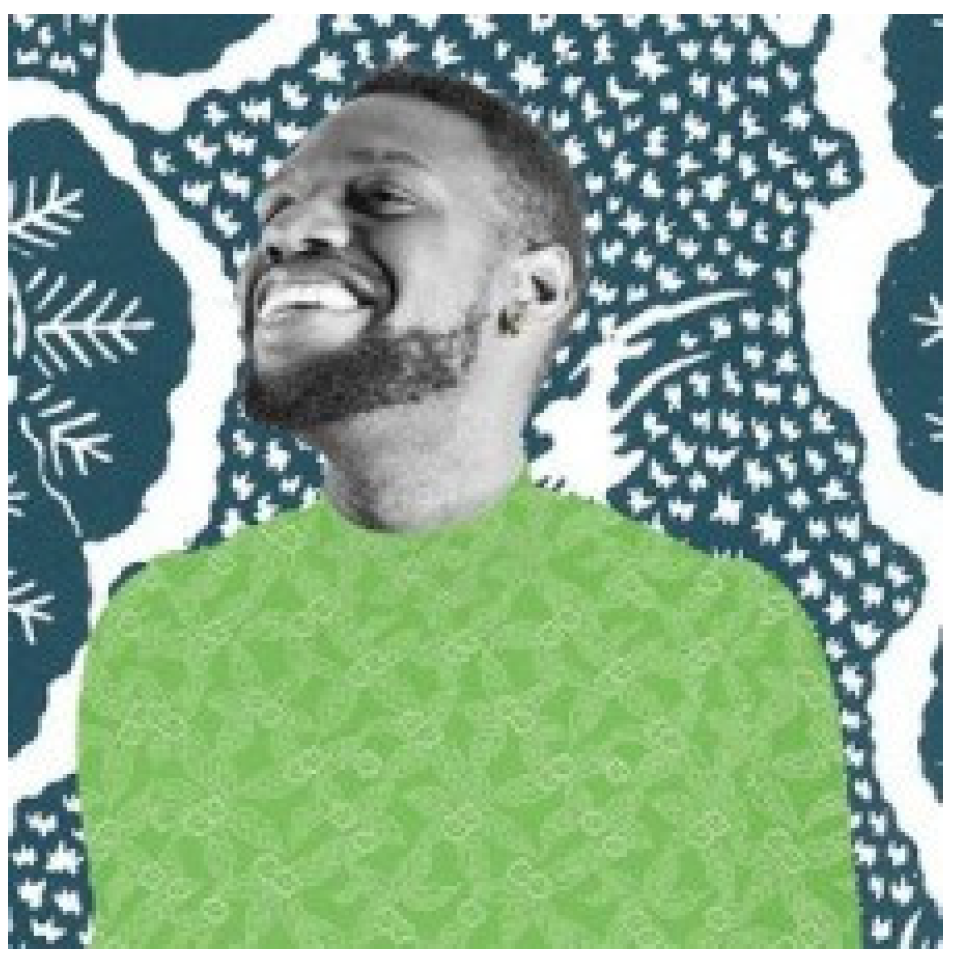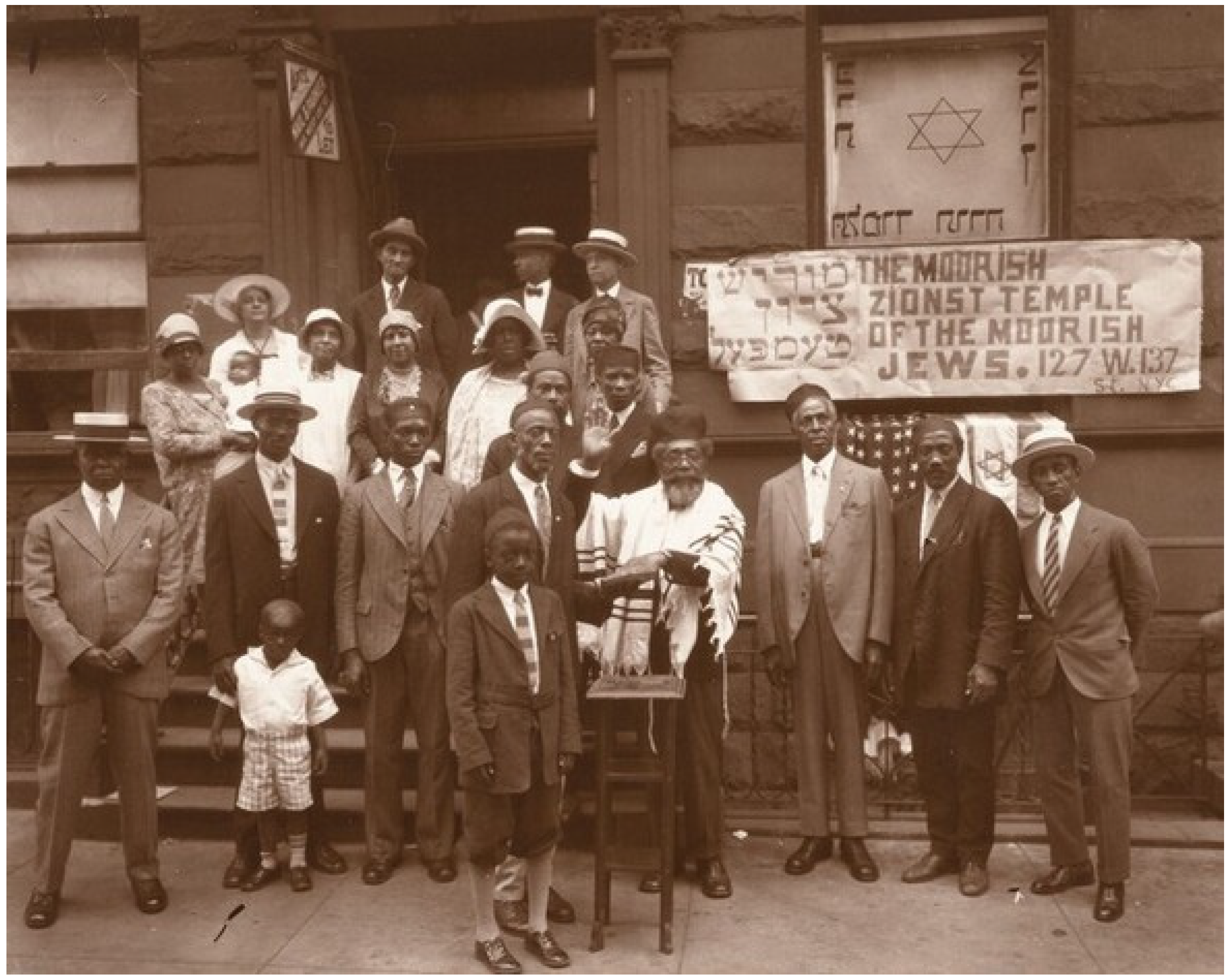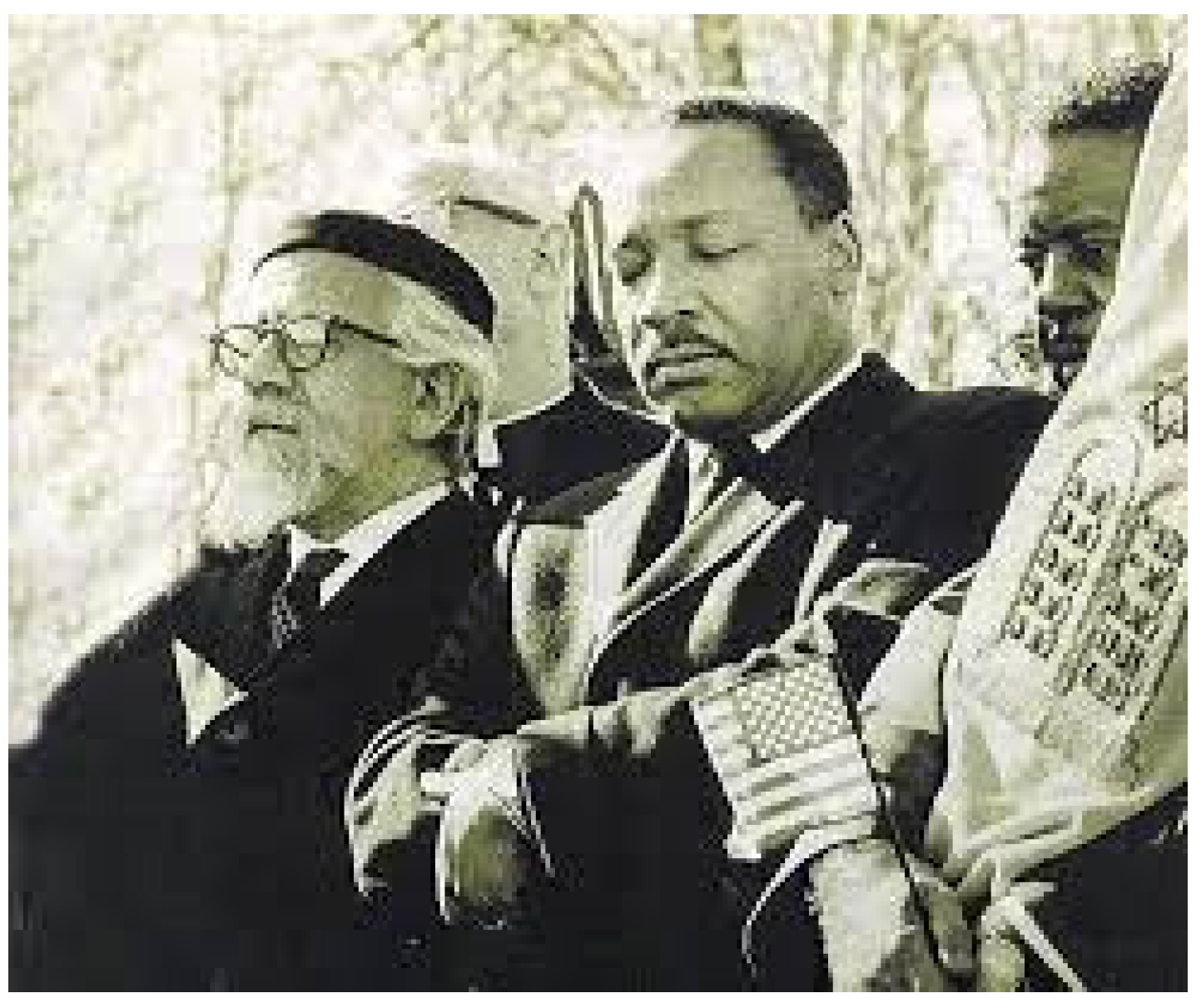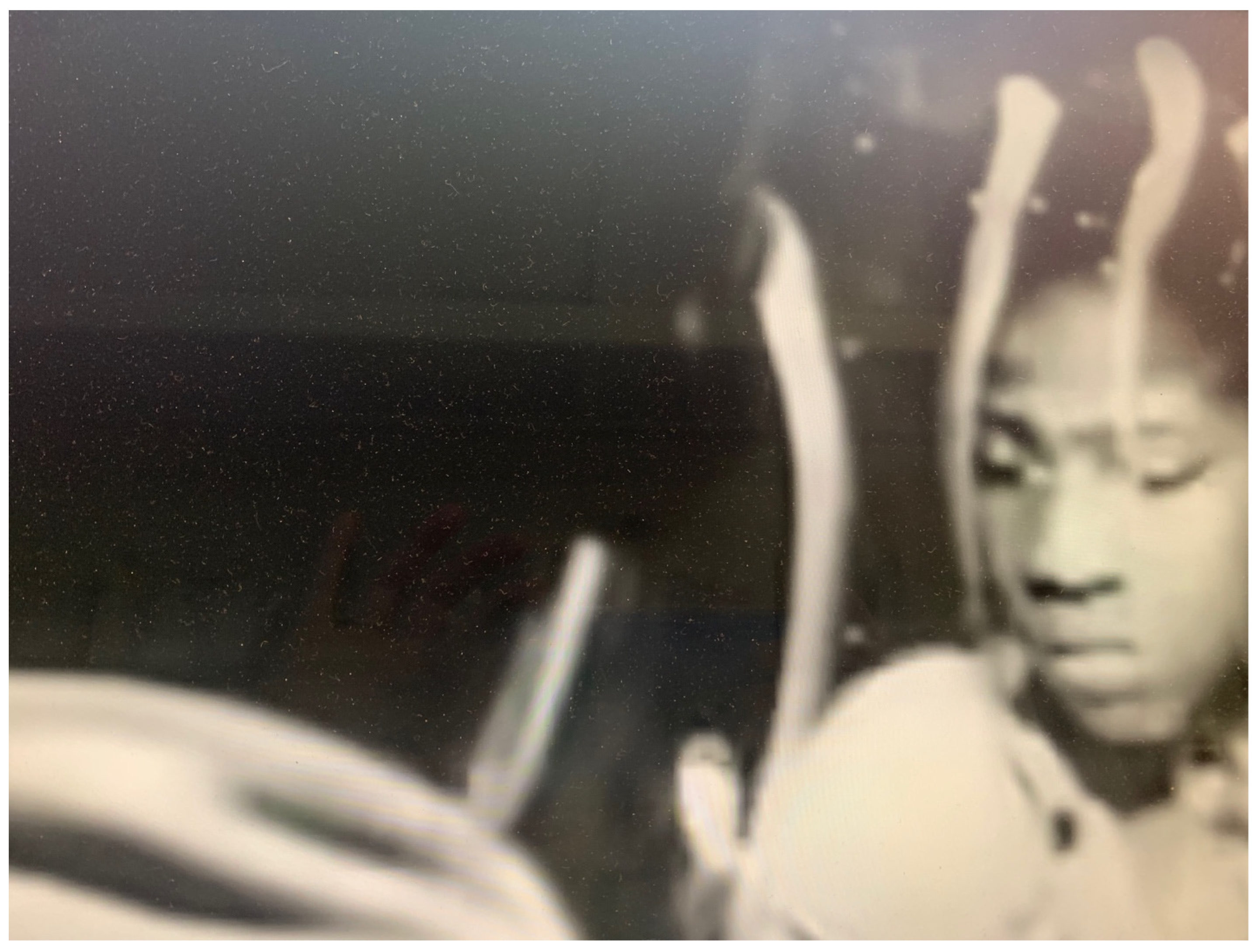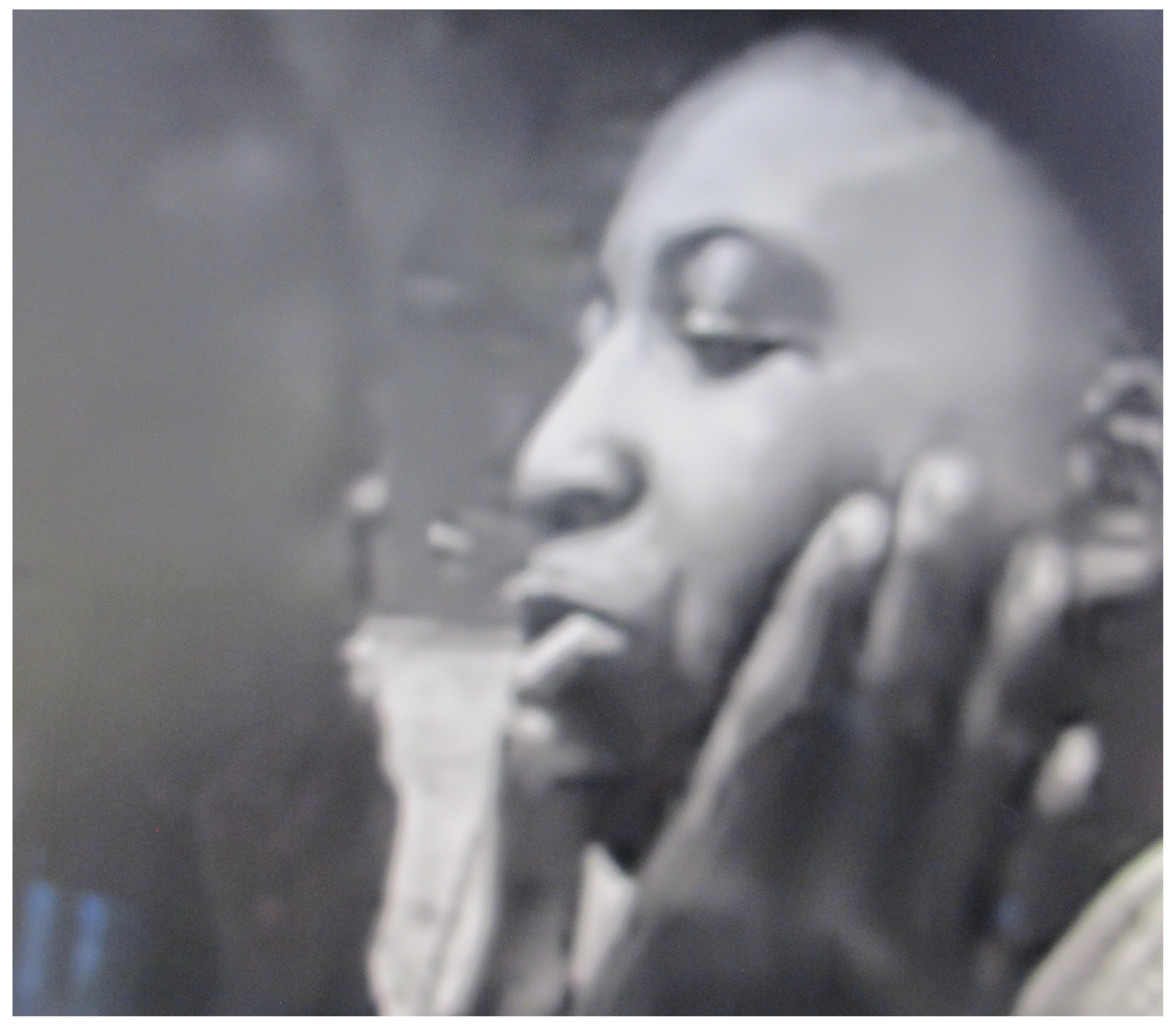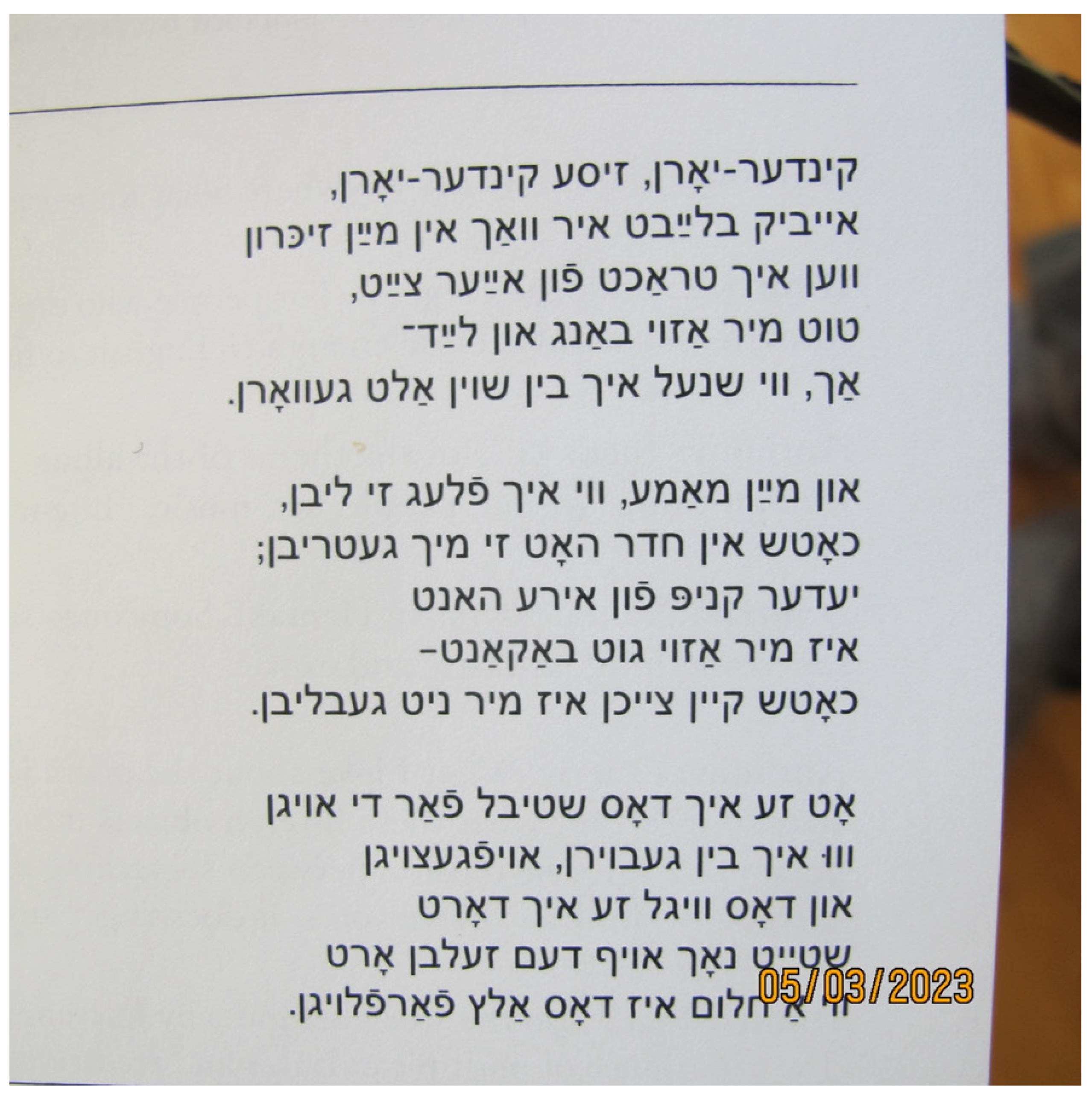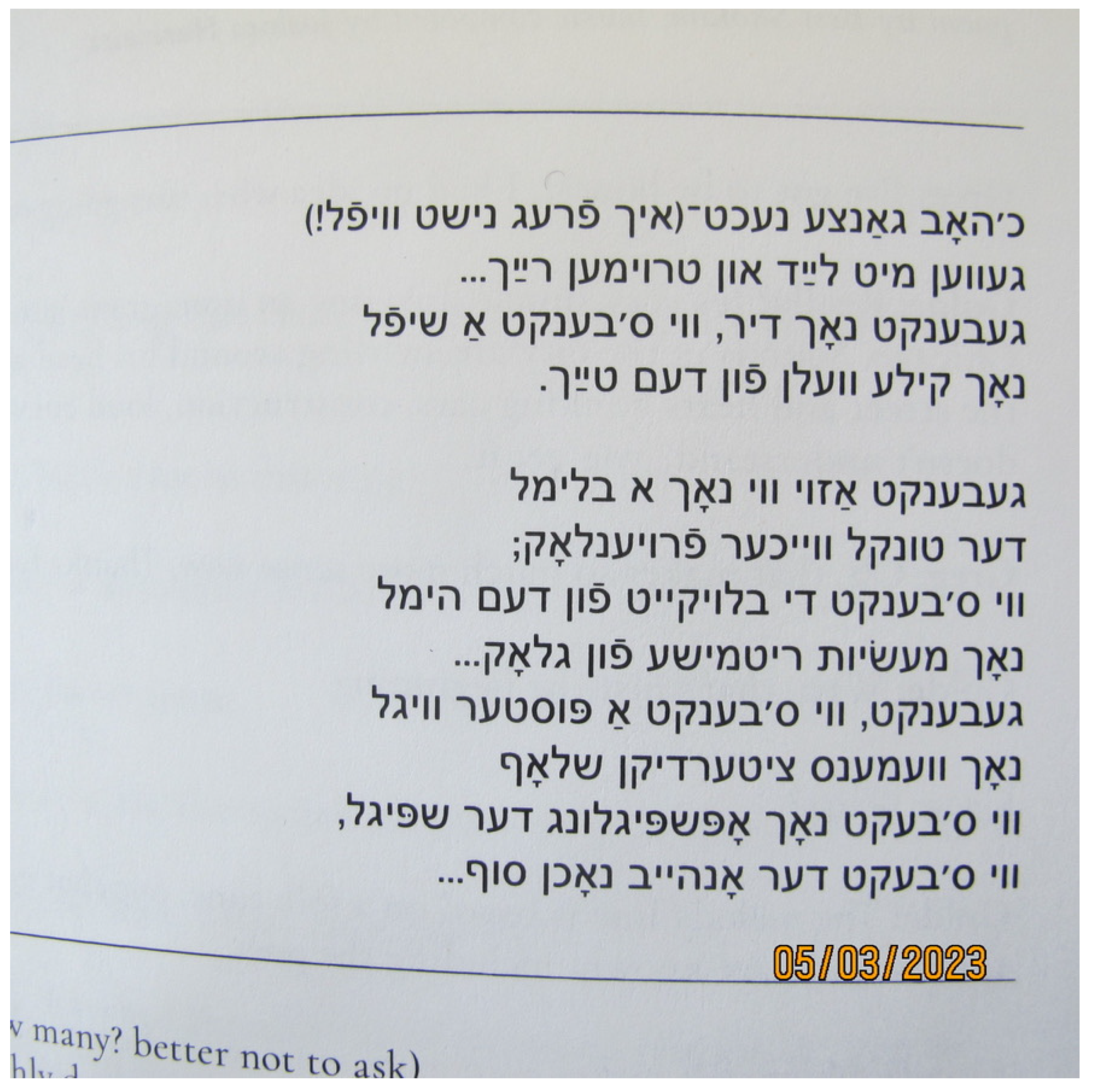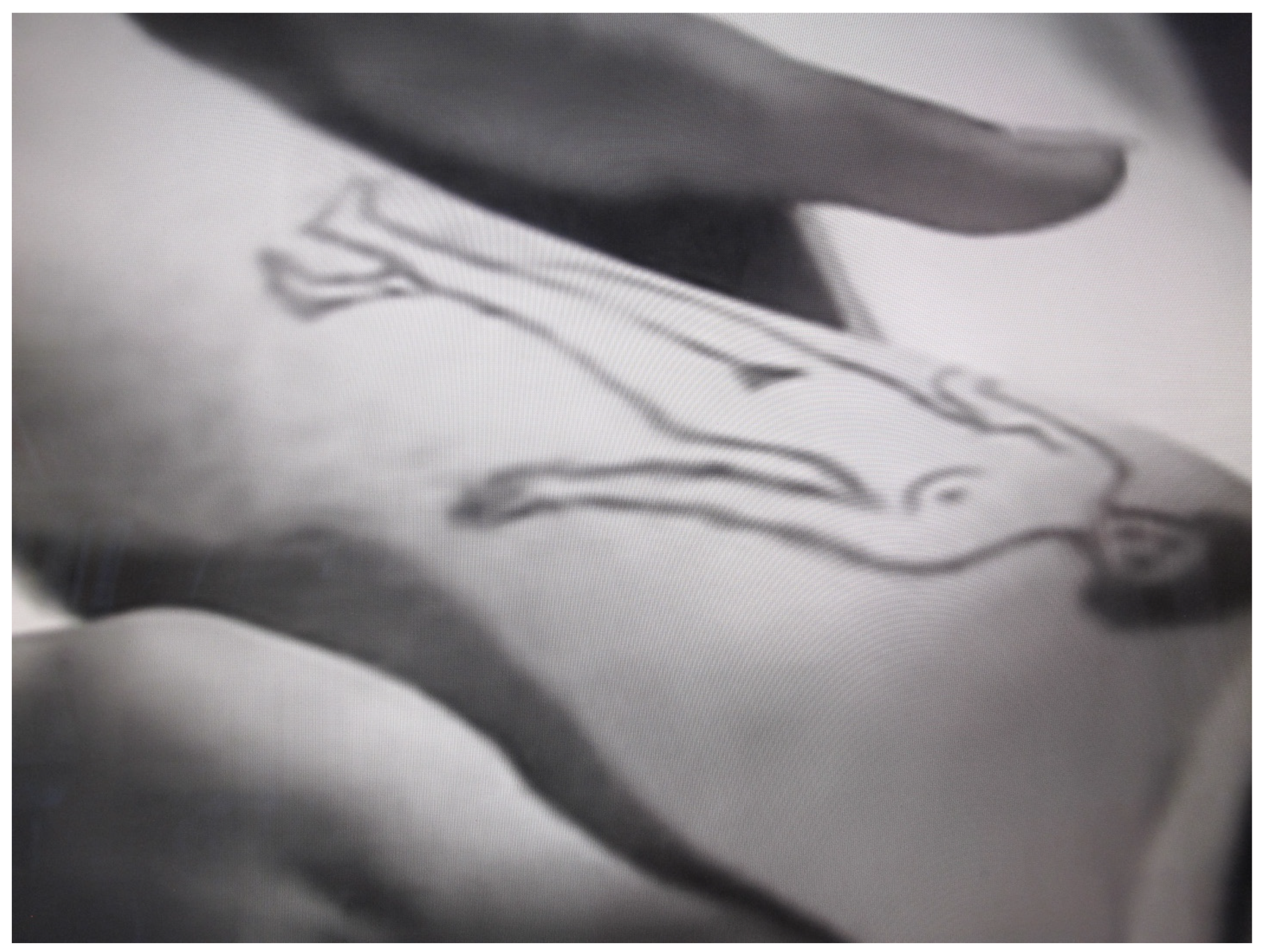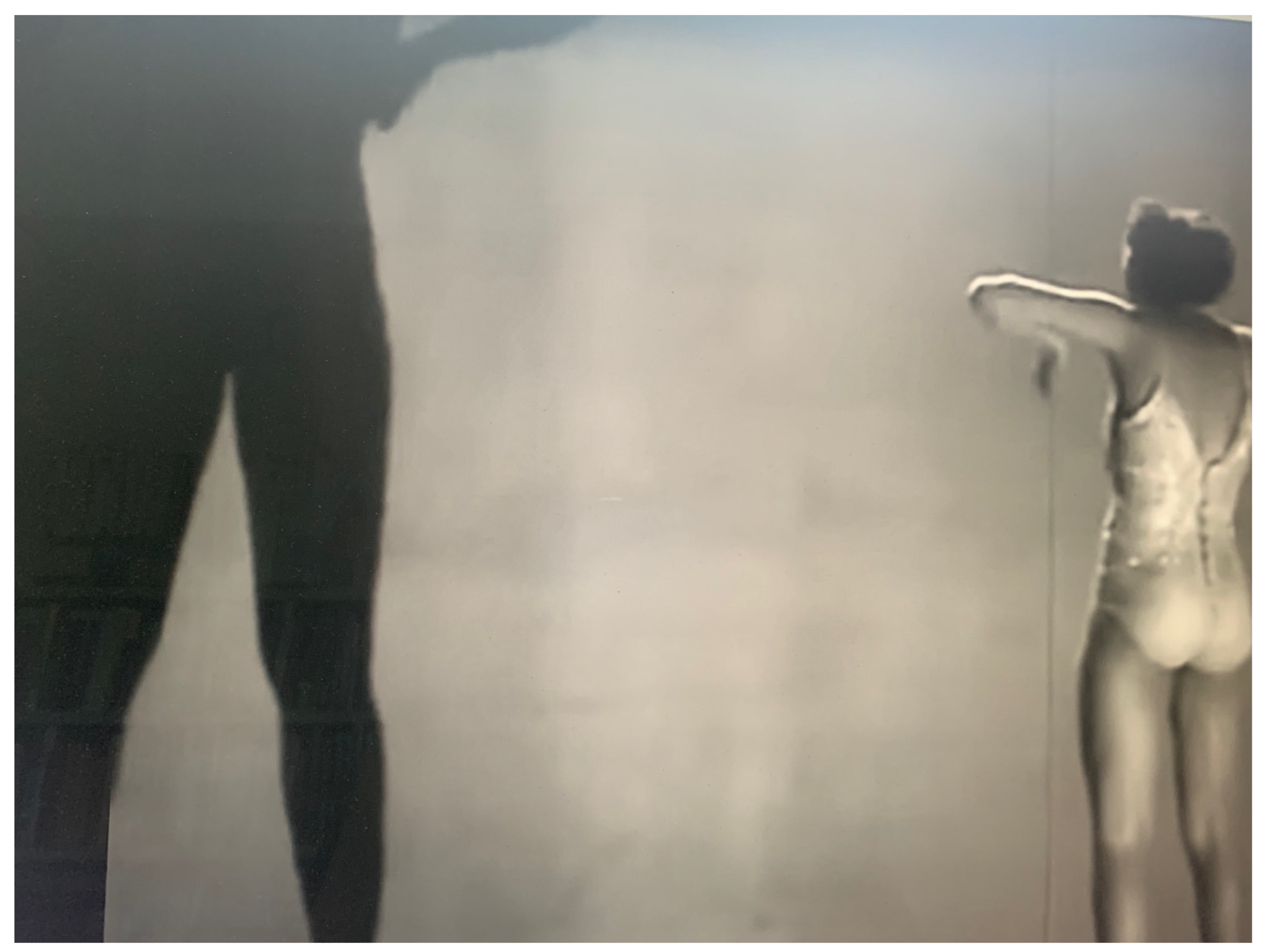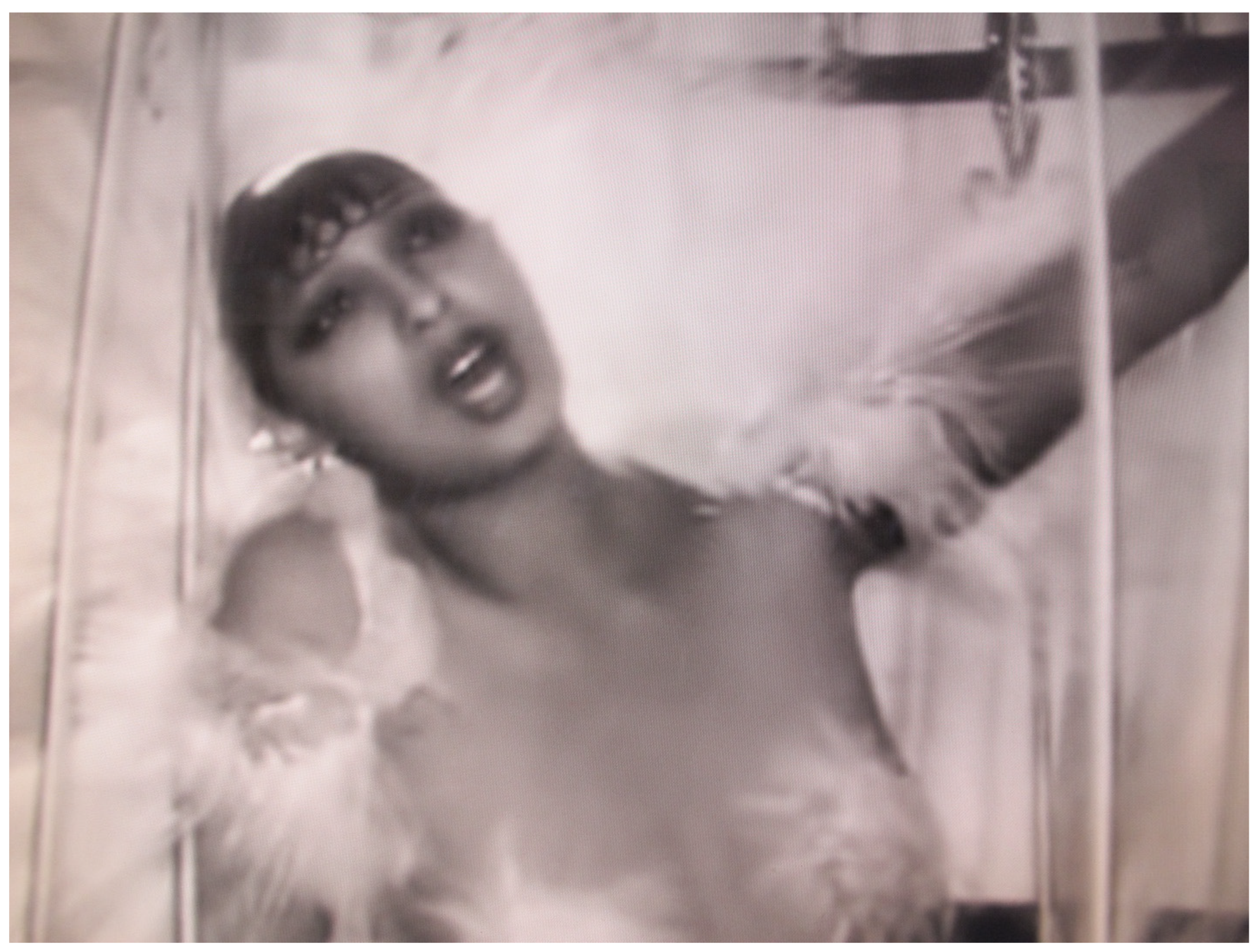2. A Bisele about Anthony Mordechai Tzvi Russell
“Solidarity with Black people doesn’t require a radical act of historical imagination. You are here. We are here. You know what to do. Do it. Now”. Anthony Mordechai Tzvi Russell, Jewish Telegraphic Agency.
Raised in a Christian, military family in Northern California, Russell trained as a classical opera singer but, through the Coen brother’s film A Serious Man, found Yiddish music, converted to Judaism, married a (male) Rabbi, and now works on a vibrant and diverse series of projects that combine African-American with Yiddish music. Keenly aware of his differences from some Jewish communities as a Black Jew but also feeling very comfortable in his role as the Rabbi’s husband—he wonderfully queers the Yiddish word “Rebbetzin,” typically translated as “Rabbi’s wife,” by applying it to himself—Russell’s life and work are deeply intertwined. He uses his personal narrative to explore musical convergences and to see moments in musical history where Black and Jewish music resonates, overlaps, or clashes and becomes Blewish music. Russell performed his project entitled “Convergence: Spirituals from the Shtetl, Davening from the Delta” at the University of Illinois in 2018. This was the first time I had heard him sing, and it was breathtaking. The performance took place during an ice storm in February and nonetheless filled a rapt auditorium to its quiet as a pin drop gills. Russell operates under the novel assumption that the walls, such as they may have been, between Blackness and Jewishness conceived as opposing identities, have always already been blurred. He embodies their aesthetic convergence. While he was in Illinois on this visit suggested by Sara Feldman that I organized as Jewish Studies Director, I interviewed him, and we discussed at length cross-cultural identifications between Jewish and Black aesthetics. By bringing Black and Ashkenazi music into dialogue, Russell’s intersectional music invites us to hear both similarities and differences. Russell’s performance and the long interview (which I hope will be included in our co-edited volume of contemporary Black-Jewish experiences) were full of the idea that these two groups have always already converged and have developed aesthetically in relation to one another. I consider Anthony a visionary, and I am grateful to Sara Feldman, again, for using this word to describe him.
Russell (see
Figure 1) was obsessed with classical music and opera from a very young age and described watching the film
Amadeus on repeat as a child. His first operatic role was a choral part in
Madama Butterfly, and his other roles included playing a preacher in
X: The Life and Times of Malcolm X and a union soldier in the Philip Glass Opera
Appomattox. Russell found Yiddish music through the Coen bothers’ film
A Serious Man—some of you will remember that Sidor Belarsky’s rich voice offers solace to the main character and figures as a refrain in the film, which concludes with Belarksy’s “Dem Milner’s Trern” (The Miller’s Tears) playing over the credits. Russell converted to Judaism and began an intensive study of Yiddish music and often combined Yiddish with African-American songs to create counterintuitive convergences.
Of his performance at the Kennedy Center, one review found Russell’s voice to be “perhaps the most beautiful I have heard in person” (
Hall 2016). Another reviewer describes Russell as a “stunningly authentic, beautifully voiced singer of Yiddish art song” (
Serinus 2015). Many other audience members and critics have been similarly wowed and moved by this innovative artist. In a project entitled
Written in Breath, Russell charts the differences and resonances between Jewish texts such as the Talmud and Yiddish songs. He performs with klezmer musicians Veretski Pass and other august artists who bring together Ashkenazi musical styles with other musical traditions.
Convergence (which is also a CD) mines diverse cultural sources such as spirituals and Yiddish labor union songs with musical idioms ranging from jazz, blues, klezmer, and gospel. This groundbreaking work challenges the divisions between identities and musical genres alike.
2Another musical convergence Russell worked on was “Yiddish meets Ladino” in conjunction with Sarah Aroeste and combining Ladino and Yiddish lyrics in a singerly trade-off. In an article in
The Forward from 2015, Russell notes that sometimes, even when singing Yiddish songs, audience members will ask him to sing ‘Ol Man River, thus completely stereotyping him. Throughout the essay, he expresses many wittily offered frustrations about people’s expectations but concludes with: “I can joke, because for the most part this has not been my fate. The immense amount of love, understanding and acceptance that I get from my overwhelmingly Jewish audiences is often intensely profound and life affirming. I’ve found a community in
Yiddishkeit that lets me establish continuities with its history and my own blackness—on my own terms. The potential for being myself that I’ve found as a singer of Yiddish is illustrative of the many expectations I have for what performing Jewishness could be” (
Russell 2015). This sense of focusing on the positive aspects of the Black-Jewish convergence that he embodies very much characterizes Russell’s approach and aesthetics and is evident in a remarkable trio of videos, two of which I turn to in the final third of this essay.
3. A Bisele Context
These convergences appear in the context of the long history of Jewishness and Blackness and their interactions in the U.S. and beyond. “Blewish” is a term that is gaining traction (and detractors) and has been used more often by folx who identify as both Black and Jewish, including Russell. With Sara Feldman, Russell and I have been working on a co-edited book tentatively (emphasis on tentatively) entitled Blewish: Contemporary Black-Jewish Voices. The anthology, for the first time, brings together interviews and essays of scholars, artists, performers, filmmakers, journalists, life coaches, and people of many different career paths and orientations to discuss and describe the complex identities they experience as Black and Jewish. Some of the people in the volume converted to Judaism, some have one white-Jewish parent and one Black non-Jewish parent, some are descended from tribes who identify as Black Jews, and others manifest different articulations of new identities. Comedian Tiffany Haddish, writer James McBride, chef and writer Michael Twitty, writer Rebecca Walker, actors Tracee Ellis Ross and Maya Rudolf, musicians Drake, Lenny Kravitz, Daveed Diggs, and filmmaker Ezra Edmond, among others, are well-known figures who have been identified as Black and Jewish.
I want to pause briefly on the example of James McBride because there are so many different pathways at the nexus of Black and Jewish, and his story brings up some of the diversities inherent in the different articulations of these identities. James McBride is the author of the novel
Deacon King Kong (
McBride 2020) and many other works, including a memoir
The Color of Water, A Black Man’s Tribute to his White Mother (
McBride 1996). In the memoir and interviews, McBride discloses that his mother, who had grown up as an Orthodox Jew, became a Church-going Christian and did not tell him or his eleven siblings until he was a teenager that she had been Jewish. McBride’s maternal grandfather, a Rabbi who ended up running a grocery store in Virginia in a Black neighborhood, was racist even though there might have been a shared sense of oppression between the two shunned communities of Blacks and Jews. McBride mentions in an interview with Terry Gross that “even though their store was in the black side of town, they weren’t welcome in town, either, you know, because they were Orthodox Jews. They were—you know, they were very religious Jews”. Despite this, McBride’s grandfather shunned any attempts to reconcile the communities, and so his mother, when she moved to New York and married McBride’s father, who was Black, was turned out of her Jewish world. McBride quotes her in
The Color of Water: “My parents mourned me when I married your father. They said kaddish and sat shiva. That’s how Orthodox Jews mourn their dead” (
McBride 1996, p. 2). His mother embraced the Church, and after her first husband died while she was pregnant with James McBride, she remained part of the Black Church community. I read
Deacon King Kong as an avowedly Christian novel with a strong message about adhering to Church communities as an inherent good. McBride, then, offers an interesting biography in that he does not identify as Jewish—and, indeed, given the history of his family, why should he?
As McBride’s biography underscores, the long history of intersections between Blacks and Jews has been at times joyous and at other times fraught with deep mistrust and betrayal. The story that is often told as one of convergence (during the shared struggles for Civil Rights) decaying into rupture and mistrust is far more complex, and sensationalized antagonisms such as those perpetrated by Kanye West (see
Dellatto and Porterfield 2022 for a summary) do not help to gain a clear picture. Many Jews (approximately 15% by some estimates) identify as multiracial and/or as Jews of Color. The Pew Research Center reports that multiracial Americans are growing by leaps and bounds—in fact, at a far faster demographic rate than the rest of the population. This increase in multiracial identities is reflected in art through myriad channels, from television to opera to painting. However, these stories often fall between the cracks of the discourse around “Blacks and Jews” when “Blacks” are assumed not Jewish, and “Jews” are assumed white.
Many groups who identify as Black and Jewish can be found further back in history than you might think. In
The Black Jews of Harlem, for example, Howard Brotz describes a vibrant community of Black Jews (see
Figure 2) who have been largely overlooked in histories about “Blacks and Jews.” Roberta Gold, discussing this same group, argues that Jews had, of course, multiple voices about race, but that “the Yiddish press… reported frequently on anti-black racism and argued that African Americans were, in effect, ‘America’s Jews.’ African Americans, for their part, drew on long theological and nationalist traditions which identified black history with that of the biblical Israelites” (
Gold 2003, p. 180). As we saw in McBride’s family, this commonality is not a given. Gold goes on to claim that both groups “found in Harlem’s Black Jews, the unexpected embodiment of what had traditionally been a metaphoric linkage” (ibid). Merle Lyn Bachman details the “horrified response of the Jewish immigrant community to lynchings and to the general plight of African Americans” (
Bachman 1980, p. 3) which not only “filled the Yiddish press” (ibid) but also appeared in Yiddish poetry. There was a group, Hatzad Harishon, which operated from 1964–1972, as Janice Fernheimer details in
Stepping Into Zion, which was a “multiracial non-profit organization that attempted to ameliorate tensions among Black and white Jews” (
Fernheimer 2014, p. 7). The long history of Black Jews—and the not unvexed identifications between white Jews and Black people of other faiths or non-faiths, is treated in a vast array of books and journal articles which I only have space to dip briefly into here. I am taking you on this detour to contextualize the work of Tsvey Brider because, by voicing Yiddish over Black cinema, they now form part of this history.
The title of Michael Lerner and Cornel West’s book-length conversation,
Jews and Blacks: Let the Healing Begin (
Lerner and West 1995), implies the rift. West evokes Josephine Baker, whom you will hear about shortly, and who echoes the riots as a disturbing turning point propelling her decision to live in France, when he tells Lerner: “We have to take seriously what Josephine Baker said…that the very idea of America makes me tremble, makes me shake, it gives me nightmares. She is referring to her girlhood in East Saint Louis amidst its riot in 1917. It was an experience that echoed that of large numbers of Black folk between 1877 and 1915, who thought about America the way Russian Jews thought about Ukraine” (Lerner and West, p. 48). The dialogue between West and Lerner is not always easy, and the comparisons are sometimes fraught. For example, at one moment, Lerner laments that more Black people in the U.S. did not advocate on behalf of Jewish refugees fleeing Nazism. To this, West takes umbrage and asks how Lerner can ignore Paul Robeson, W. E. B. DuBois, and other public figures’ efforts on behalf of Jewish causes (53). The dialogic nature of the text necessarily leaves many issues unresolved but offers a space to explore the histories of both convergence and divergence, support, neglect, and hope.
Other texts also take, as does the Lerner–West discussion, the rift as the starting point.
Jonathan Kaufman’s (
1988),
Broken Alliance: The Turbulent Times Between Blacks and Jews in America tells many fascinating stories, including that of Paul Parks, a Black soldier who helped to liberate Dachau and then, some twenty years later, marched with King in Chicago as racist whites waved swastikas, hung Nazi banners, and threw a brick at King, hitting him on the head. “Once again”, Kaufman reports, “as King listened, he [i.e., Parks], told the story of a young black soldier walking into Dachau” (
Kaufman 1988, p. 77). This sentiment, however, of identification between Blacks and white Jews was, by the mid-1960s, according to Kaufman, “increasingly out of date” (
Kaufman 1988, p. 78). In his 2005
Strangers in the Land: Blacks, Jews, Post-Holocaust America, Eric Sundquist (
Sundquist 2005) takes as his starting point the rift between Blacks and Jews, and this registers a turning point; he argues throughout that each relied on the other for their self-conceptions. He takes note of Black Jews and other Jews of Color and thus does not leave these identifications out of the discourse around “Blacks and Jews” when Jews are implied white and Black people are implied non-Jewish. He also asserts that “the black-Jewish question is intrinsic to and inextricable from any understanding of American culture” (
Sundquist 2005, p. 12) and that “the importance of blacks for Jews and Jews for blacks in conceiving of themselves as Americans…is a matter of voluminous if often perplexing record” (
Sundquist 2005, p. 1).
One perplexing record can be found in the films and life of Spike Lee. An important thread of Jewishness runs throughout Lee’s films, from stereotyping of Jewish characters in
Mo’ Better Blues (1990) to mention of Jewish women in
Jungle Fever (1991);
Get on the Bus (1996) features a Jewish bus driver who refuses to transport a group of people to hear Louis Farrakhan because he views him as antisemitic. A brief but fascinating critique of Jewish appropriation of Blackness emerges in
Bamboozled (2000), and then
BlacKkKlansman (2018) offers multiple layers of influence and interconnection between Jewishness and Blackness (please see my article on
BlacKkKlansman (
Kaplan 2020) for more on this). This thread may have a biographical element: Lee’s mother died of liver cancer when he was in college—Morehouse in Atlanta; his father then began dating a Jewish woman, Susan Kaplan-Lee whom he later married—much to Lee’s discomfort and disapproval. Lee told the journalist and memoirist Barbara Grizutti Harrison in
Esquire that he “hate[s] the woman. She’s not a nice person. She’s a bad person. It’s not because she’s white and she’s Jewish. I just hate her” (
Harrison 1992, p. 137). Lee goes on to describe how, unlike the way in which step-mothers should behave, approaching the new family with humility, she “came like gangbusters. My mother wasn’t even cold in her grave” (ibid). Harrison describes Susan Kaplan as “Lithuanian and the descendant of rabbis but considers herself ‘spiritually black’” and adds, parenthetically, “(She wears dreadlocks)” (ibid). Biographically, Jews and Jewishness figured in Lee’s life from his mother saying things like “I bet you John Silverburg, I bet he got a 95. You gotta be gettin’ those same grades the Jewish kids are gettin’” (
Harrison 1992, p. 136) through to his father’s second marriage and through many other friendships and interactions. By the time Lee made
BlacKkKlansman (2018), he had situated the proximity and sympathy between Jewishness and Blackness within a fascinating story based on a memoir by Ron Stallworth (although in the memoir, the white cop is not Jewish) of a Black man who infiltrated the KKK and befriended a white Jewish cop in the process.
I am focusing on Blacks and Jews and Blews in America, but the history in Europe, Africa, the Caribbean, and other places is also long and complex. In
Black Jews in Africa and the Americas (2023), Tudor Parfitt points to the “linkages of different sorts between blacks and Jews in medieval Europe,” which were common (
Parfitt 2013, p. 3). He continues, “in Europe, for hundreds of years, being black, Jewish, sickly, and ugly became almost coterminous” (
Parfitt 2013, p. 7).
BlacKkKlansman also pointed out the dual hatred borne by the KKK towards Blacks and Jews, although historically, Blacks suffered much more from their racism than did Jews. This amalgamation through negative stereotyping did not negate the later flourishing of many Jews in Africa who felt there was no discord between Blackness and Jewishness. For the co-edited collection we are working on, we interviewed Rabbi Gershom Sizomu, who is a leader of the Abayudaya Jewish community in Uganda. The question of tension between identities of Blackness and Jewishness that so many others we talked to circled around was nonsensical to a Rabbi in a world where everyone is Black, and being Jewish is the anomaly.
In her brilliant study,
Calypso Jews: Jewishness in the Caribbean Literary Imagination (
Casteel 2016), Sarah Phillips Casteel charts the long history of intersections between Jewishness and Blackness in the Caribbean, focusing on “contact and entanglement” (
Casteel 2016, p. 2). “Instead,” Casteel says, “of treating Black and Jewish experience as discrete terms in an analogy between disparate historical experiences…” her book “foreground[s] areas of overlap between these diasporic histories and the ways in which they converged in the Caribbean (
Casteel 2016, p. 12).
3 A longer essay could also delve into really interesting convergences, including the famous story of the Jewish songwriter and poet Abel Meerpol, whose lynching poem, “Strange Fruit,” became a chilling and bestselling song when sung by Billie Holliday. There is perhaps an echo of “Strange Fruit” in the Yiddish verse played over Black cinematic images that I discuss below. Other pairings include the Jewish songwriter George Gershwin who created
Porgy and Bess and insisted that it only be performed by Black singers and actors. From these brief samplings so far, I hope it is clear that there is not one story of “Blacks and Jews” or Black Jews. In so far as any story is told, it almost always points to an arc whereby the apex of white Jewish support for Black liberation came during the Civil Rights movement but was eroded afterward and reached a nadir in 1991, during an infamously awful series of events in Crown Heights.
In
Fires in the Mirror: Crown Heights, Brooklyn, and Other Identities, the performance artist Anna Deavere Smith probed into the 1991 violence and tensions between Blacks and Haredim in Crown Heights. After a rebbe’s motorcade hit and killed a Black child, Gavin Cato, riots erupted, and then, in retribution, a Hasidic teenager, Yankel Rosenbaum, was stabbed to death by an angry mob. Unpacking the events leading up to the violence and the reactions from Black and Jewish leaders afterward, Deavere Smith’s performance art is a daring exploration of the problems between Blacks and white Jews in this neighborhood that can be understood as a microcosm of larger tensions and anxieties. When these horrific incidents unfolded, there was a sense that the convergences between Blacks and Jews, fighting shoulder to shoulder as encapsulated in the image of Martin Luther King, Jr. and Rabbi Abraham Joshua Heschel (see
Figure 3 for a photo from 1968) marching to Montgomery on 21 March 1965 for Civil Rights, had been erased and what was left was only violence and betrayal.
Smith’s complex performances probe these questions with sensitivity to the cross-cultural identifications evident in her transformations. In a reading of Smith’s performances, Cherise Smith aptly claims that Anna Deveare “Smith not only locates and embodies a liminal space in which identity is neither stable nor fixed, but she also models how to occupy the liminal space” (
Smith 2011, p. 163). This liminal articulation of multiple and fluid identities resonates with the converged aesthetics in Russell’s work.
Multiple versions of the story of Black-Jewish relations, histories of Blews, configurations of discord, and convergence remain ever-shifting. Advocacy groups such as Be’chol Lashon, the Jewish Multiracial Network, and Jews in All Hues provide important networking forums for Jews of Color, and there is a rise in the number of Jews who identify as Black or as Jews of Color, so the entire landscape of Jewishness is now and has always been in the process of metamorphosizing. By turning now to two short videos by Anthony Mordechai Tzvi Russell, I want to look at how these works begin from a place of convergence and trust that the racialized and gendered oppressions they work through are legible together.
The videos, each under a few minutes, are readily available on the Tsvey Brider website and can be seen here. Please take a few moments to look at “Kinder Yorn” and “In Der Fremd” before reading further; thank you:
http://tsveybrider.com/ (accessed on 7 May 2023).
4. Kinder Yorn
“Kinder Yorn” is a song by Mordechai Gebirtig, which Russell sings beautifully to an arrangement made by Tsvey Brider’s Dimitri Gaskin. Gaskin, an accomplished musician who studied with Josh Horowitz and Alan Bern, composes, arranges, and plays accordion with Saul Goodman’s Klezmer Band and other groups in addition to Tsvey Brider. He teaches at festivals, including KlezKalifornia and others. Mordechai Gebirtig (1877–1942) was dubbed the “poet laureate of Yiddish folklore” and, according to Neil Levin, “Gebirtig’s songs, along with those of his poems for which he did not furnish music, spoke to the sensibilities, emotions, and concerns of the common Yiddish-speaking folk of prewar and interwar Poland and Galicia; and they could resonate equally among an educated proletariat or more sophisticated participants in the Yiddish cultural arena” (
Levin 1997). In Tsvey Brider’s “Kinder Yorn” video, Russell’s voice plays over images intercut from two films of the 1940s:
The Quiet One (1948) and
The Blood of Jesus (1941). The images of the young child walking backward and alone through city streets are from
The Quiet One, a film narrated by a white actor playing a white psychologist about a school for mainly Black and Latino boys, Wiltwyck, in Esopus, New York.
The Quiet One embodies a moment of Black-Jewish convergence and collaboration as it was made by three Jewish filmmakers, Sidney Meyers, Janice Loeb, and Helen Levitt, and a Black musician Ulysses Kay, whose “Suite from the
Quiet One” was “performed by the Yaddo Music Group Chamber Orchestra” (
Wranovics 2012, p. 218). The actors, both trained and untrained, including Clarence Cooper, a counselor at Wiltwyck who played himself (
Wranovics 2012, p. 216), worked with the filmmakers to collaborate on the project.
The combined effect of these films of Black actors accompanied by Yiddish songs can be read as a double act of resistance against genocide. It is often said that Yiddish is a dying language. This is and is not true. On the one hand, many of the millions of people who were murdered in the Nazi genocide were Yiddish speakers. At the same time, assimilation on the other side of the Atlantic was rapidly reducing the vast numbers of Yiddish speakers in New York city—Yiddish daily newspapers declined, and many Yiddish-speaking immigrants actively encouraged their children to speak English, not Yiddish. On the other hand, there has been a creative and vibrant revitalization of Yiddish—and Russell is an exemplar of this spirit. Yiddish programs are growing, and many non-Jews study the Yiddish language, culture, literature, and history. There are large numbers of Yiddish speakers among Haredi communities in New York, Israel, and other places. Jeffrey Shandler argues that in the twenty-first century, the symbolic importance of Yiddish is growing by leaps and bounds even while the number of its speakers may not be growing so fast (
Shandler 2008, p. 5). However, the fact of genocide of many of its speakers sometimes lends Yiddish a mournfulness which Russell’s work by turns embraces and outpaces, celebrating the vibrancy of Yiddish’s reflowering.
Many scholars have looked at
The Quiet One and connected it with its Italian neorealist counterparts, such as Vittorio de Sica’s
The Bicycle Thief (
Ladri di bicicilette which came out the same year, 1948) or
Shoeshine (
Sciuscià, 1946). Analyses by Michele Wallace (
Wallace 1993), Siegfried Kracauer (
Kracauer 1997), Paula Massood (
Massood 2013), Robert Sklar (
Sklar 2012), Vojislava Filipevic Cordes (
Cordes 2021), John Wranovics (
Wranovics 2012), Dennis Doyle (
Doyle 2016), Stephen Charbonneau (
Charbonneau 2016), and others often stress
The Quiet One’s connection with the leftist films made by the Workers Film and Photo League and its splinter groups such as Nykino, Film Documents, and others. The film was made, according to James Agee, as “a new form of movie short roughly equivalent to the lyric poem…each image, (like each word in poetry) must have more than common intensity and related tension” (cited by
Wranovics 2012, p. 202). This lyric poetic cinematic amalgam of documentary and dramatization was inaugurated by Janice Loeb, whose letter to Wiltwyck John Wranovics found in the MOMA archives. Loeb, in 1946, had visited Wiltwyck and wrote to the school to suggest a film that would “stimulate support for its ideas of child care and treatment” (cited in
Wranovics 2012, p. 214).
The film takes a dramatic approach to what is ostensibly a documentary subject. (Kracauer dubs it “a documentary with a found story of high compactness” (
Kracauer 1997, p. 252)). It weaves dramatic re-enactments of the life of a traumatized kid with a documentary story about a psychological profile woven from an amalgamation of different stories of children who landed in Wiltwyck. The school in Esopus, New York, enjoyed support from the likes of Eleanor Roosevelt and other prominent figures.
4 The fictional child, Donald Peters, is played by Donald Thompson, an untrained actor whose sole role this film apparently claimed. Ernest Pascucci describes Thompson as “an outgoing and articulate honors student from a supportive and stable two-parent family, whom [the filmmakers] described as the exact opposite of the character he portrayed” (
Pascucci 1997, p. 26). It is a documentary, then (or, in Pascussi’s term, a “noir docudrama”) in a very curious sense because the deeply affecting story we are given as true is both harvested from multiple children’s histories and heavily dramatized. The Black child at the center of the story is overwritten by white voices, so there is a bit of a see-saw between the good intentions of the white Jewish filmmakers and a certain vacating of Donald’s subjectivity.
Within the film, we see that Donald’s mother abandoned him, his father is absent, and he has been deposited with his grandmother, who beats him and only cares for him minimally and due to obligation rather than love. Donald clings to an arresting photograph of the family scene at the beach: little Donald digging in the sand at the bottom of the image: scroll up, and the head of Donald’s father is cut off—his mother and grandmother stand in the scene, ignoring him. If we recall Roland Barthes’s (
Barthes 1980) theory of photography and remember that he argued for a “punctum” in many photographs: a point that draws the viewer in and offers the key to the emotion of the image, we can say that the punctum of this photograph is the missing head of the father, the absence that haunts Donald. Made with all the best lefty intentions by Nykino sympathizing Film Documents, the film was illuminated by the hope that class transformation could come even to America.
5 Race is not a category, per se, in the film, although the principal actor, a child whose first and only role this was, is Black, lives in Harlem and is a product of a racist society. However, for the idealistic trio of Jewish-American filmmakers, photographers, and cinematographers Sidney Meyers, Helen Levitt, and Janice Loeb, race was not the point: class, poverty, and perhaps more saliently still, hope for neglected children to receive proper psychiatric care and overcome at least some of their traumas, was. Michele Wallace underscores that the child is not allowed “to speak in his own voice (rather the psychiatrist paraphrases his remarks from their psychoanalytic sessions)” (
Wallace 1993, p. 268). Wallace also argues that “in
The Quiet One, the women are nothing more than lifeless shadows” (ibid). Thus, with all good intentions for social transformation, the film, again, it is 1948, fails to fully realize the interiority of the Black characters who populate it—or rather, to let that interiority be told in the voice of the children. When Russell and Gaskin export Donald into the 2000s and offer him a Yiddish song about childhood, they completely transform both our reading of the film and our attachment to the child at its heart.
As viewers of
The Quiet One, we identify very strongly with this kid. It makes intuitive sense when, in a powerful scene that takes place during a visit to his mother, in response to her cold-fish reception of him, Donald smears cold cream all over the mirror, obliterating his image (see
Figure 4). If Lacan’s famous mirror scene is a developmental recognition of wholeness, this child’s actions symbolize a moment of self-eradication in the face of ever more hurtful rejection. However, the filmmakers are careful to assert that he did not blot himself out completely: he smudged, and there is room to clean up the act, make the image whole and clear and bright. Instead of smashing the mirror, the child smashed another glass, a shop window, and it is this breaking that ultimately will lead to the glimmers of hope for his future. The film avowedly eschews all simple, happy endings.
6 James Agee, who was brought on to lend his poetic stamp, invokes this mirror scene in his closing narration, read by the actor Gary Merrill (who played Bette Davis’s husband in
All About Eve): “Lest the generations of those maimed in childhood, each marking the next in its own image, create upon the darkness, like mirrors locked face to face in an infinite corner of despair. We want only to keep open a place of healing, courage, and hope” (cited in
Wranovics 2012, p. 218).
7Robert Sklar notes that when
The Quiet One came out, Agee was understood to be one of the most important film critics in the U.S. (
Sklar 2012, p. 74). In 1936, Agee (
Agee 2005) traveled with Walker Evans, documenting the extreme poverty he found and producing together the images and text (meant to be read aloud) which constitute
Let Us Now Praise Famous Men. This now iconic series of images of poverty would have been very much in the zeitgeist at the time of Agee’s collaboration on
The Quiet One. Agee’s poetic input into the film sounded a crucial voice at a time when his recognition was paramount. The film enjoyed critical success with accolades from the likes of everyone from Charlie Chaplin to Fritz Lang, Elia Kazan, John Huston, and others—but it was not a smash hit at the box office and even attracted the unwelcome attention of the FBI (
Wranovics 2012, pp. 221–22). One early critic, Vinicius de Moraes, in 1950 wondered whether “the message of
The Quiet One did not transcend the intent of its producers without their being conscious of the fact. The film attacks the racial problem with the most powerful and precise of weapons—poetry” (
De Moraes 1950, p. 376).
8On Valentine’s Day 1949, Bosley Crowther enthused in
The New York Times that
The Quiet One was a “genuine masterpiece” and continued to note that “the race of the boy is a circumstance. For this is essentially the story of any child who has hungered for love and, in the misery of that hunger, has rebelled in some unsocial way” (
Crowther 1949). In claiming, again in 1949, that race is a “circumstance,” Crowther implicitly aligns himself with the ethos of Meyers, Loeb, and Levitt, who made the film to encourage support for Wiltwyck and, more broadly, to catalyze hope that troubled youth can overcome trauma through therapeutic practice. Their vision would have been following the communist idea that class trumps race. As Lilya Kaganovsky has shown in the context of the Soviet cinema in which the filmmakers of
The Quiet One would have been immersed, race, with which the Soviets were obsessed (and for an absence of inequality around which they criticized the U.S.), is nonetheless erased in favor of class and work. In
The Voice of Technology (
Kaganovsky 2018) describes a scene in the
Return of Nathan Bekker (1932) where Nathan brings home from America to the USSR a bricklayer. Upon meeting him, Nathan’s father asks if Jim, who is Black, is a Jew. Nathan’s response? “He is a
bricklayer” (
Kaganovsky 2018, pp. 160–61) (see also
Senderovich 2022). Indeed, it was Donald’s poverty and trauma, not his race, that the filmmakers of
The Quiet One wanted us to focus on. Of course, we can see now that there is no way to separate these intersectional identities and that racism contributed to Donald’s loneliness, poverty, and trauma.
Musing on
The Quiet One as a film that evokes stark reality through a dream-like quality, the hugely influential film scholar and cultural critic Sigfried Kracauer pondered that “perhaps films look most like dreams when they overwhelm us with the crude and unnegotiated presence of natural objects—as if the camera had just now extricated them from the womb of physical existence and as if the umbilical cord between image and actuality had not yet been severed” (
Kracauer 1997, p. 164). Kracauer will have been well aware that his metaphor here is manifest in
The Quiet One through the endless longing Donald exhibits for his missing mother. Indeed, it is the word “baby” written on the blackboard at Wiltwyck that inaugurates within the film the very long flashback to his life before the twin idylls of the countryside and the psychiatrist intervened to save him.
It is entirely possible that I missed something, but in all the scholarship on
The Quiet One that I perused, I did not see one reference to a scene wherein Donald befriends, briefly, two boys slightly older than him. The three enjoy a poignantly short-lived moment of camaraderie on the streets of Harlem, where they try to take in a film in the afternoon. The two new friends, mimicking the movie poster, embrace and kiss (see
Figure 5). It is an exuberant moment that passes quickly as the trio dissolves and Donald is once again left alone, wandering, as we see him in “Kinder Yorn.” The film, interestingly for 1948, does not recoil at this homoerotic exploration. Indeed, this is one of the only times we see Donald smile as he watches the pair. This queering links the two videos made by Tsvey Brider, “Kinder Yorn,” and “In Der Fremd,” and, more importantly, allows us to read the hopefulness of the film more fully—expanding it out beyond hope for racial equality and into equality of all kinds.
As will also be the case with “In Der Fremd,” a remarkable number of resonances between the Yiddish song and video allow us to reflect on these profound convergences. Gebertig’s “Kinder Yorn” (see
Figure 6) and Donald’s experience depicted in the film illuminate the short, powerful video and provide a stellar example of converged aesthetics.
- Childhood, sweet childhood.
- Your memories will stick with me forever.
- Just thinking about it gets me all torn up inside—
- It’s like I grew old overnight.
- And my mother—how much I loved her—
- Even if she had to drag me to school.
- Every single little pinch from her fingers—
- It’s the memories that linger, even if the pinches don’t.
- There it is—the shack where I was born and bred—
- And like the crib is there too, in the selfsame place;
- Like a dream, all of it is fading…
Moving through the song line by line, we see that there is nothing “sweet” in Donald’s childhood years. However, by singing mournfully over the image of the delicate, lost child alone on the street, Russell grants him some hope for future sweetness. “You’ll stay alive…” is, of course, true for trauma survivors, and by marking that here we see the indelibility of that memory even though the valence is transformed from honeyed to angst-laden. The nostalgia that grips the protagonist of Gebirtig’s song could be transferred to the nostalgia Donald may feel for the idyll of Wiltwyck. We never know what happens to him, later in life, of course, or how his therapeutic transformation ultimately played out, but we can imagine that perhaps this bracketed time in the countryside could evoke such nostalgia. The remnants of the “shack” still visible to the narrator of the song again underscore the memory of poverty that Donald will always carry. “Like a dream,” we see the resonance immediately between the dream-like qualities Kracauer pointed out in the film and the dream-memory scape of the song. There is the uncanniness, too, of the crib in the song and the crib in
The Quiet One. In a devastating scene, Donald goes to visit his mother. Not only, as I mentioned above, does she not greet him warmly, but she promptly puts him in charge of the baby who lies in the cradle so she can go out with her man. Donald, naturally, is in no emotional state to care for anyone, and he replicates his mother’s abandonment of him by leaving the crying baby alone in the apartment as he wanders the streets yet again, an achingly lonely flaneur. “My faithful mother I’ve lost as well” (this appears in a different translation of the poem—the translation in
Kosmopolitan is closer to the original, the other translation is on the website (see
Gerbirtig n.d.). Donald never had a faithful mother, but he did have a lost mother, and this near-closing moment of the song leaves us with the impression that, in old age, one is destined to lose one’s mother, and thus the premature loss of her in Donald’s story is achingly painful and yet resonates with the less-sharp sense of loss experienced by the narrator of the song. Mordechai Gebirtig was shot in the ghetto in Krakow in 1942.
The powerful emotional resonance of Russell’s voice as he sings in Yiddish offers what I can only imagine is care for this lost kid, mourning for Gebirtig and other victims of the Holocaust, mourning for victims of racism and poverty. The amalgam of song and image, Yiddishkeit and Blackness, makes this short video an aesthetically converged moment of compassion and identification.
5. “In Der Fremd”
In the video entitled “In Der Fremd,” Russell’s voice sings in Yiddish while Josephine Baker sings something else unknown to viewers of just this artistic reworking. Borrowed from Marc Allégret’s 1934 film
Zouzou, in which Baker plays the eponymous character, the Yiddish words express all the longing so acutely felt by Zouzou. In “In Der Fremd” Russell queers Josephine Baker. She becomes familiar and strange at once. He makes her Jew—ish by inserting Yiddish under her tongue. Baker had been, according to her son, Jean-Claude, who wrote one of the many biographies, bisexual, and she had cross-dressed (see
Figure 7). Scholarship on Baker often turns to this queerness. Consider, for example, K. Allison Hammer’s reading which argues, “Baker therefore performed in
La danse sauvage and
la danse des bananes the queer plasticity and transferability of the phallus” (
Hammer 2020, p. 166).
From the very moment of her life-changing appearance in Paris in 1925, Baker had been perceived as man and/or woman, as Black and/or white, as human and/or animal. Here is Pierre de Régnier in the weekly newspaper
Candide in 1925:
Joséphine Baker.
Est-ce un homme? Est-ce une femme ? Ses lèvres sont peintes en noir, sa peau est couleur de banane, ses cheveux, déjà courts, sont collés sur sa tête comme si elle était coiffée de caviar, sa voix est suraiguë elle est agitée d’un perpétuel tremblement, son corps se tortille comme celui d’un serpent ou plus exactement, il semble être un saxophone en mouvement et les sons de l’orchestre ont l’air de sortir d’elle-même; elle est grimaçante et contusionnée, elle louche, elle gonfle ses joues, se désarticule, fait le grand écart et finalement part à quatre pattes, avec les jambes raides et le derrière plus haut que la tête, comme une girafe en bas âge. Est-elle horrible, est-elle ravissante, est-elle nègre, est-elle blanche, a-t-elle des cheveux ou a-t-elle le crâne peint en noir, personne ne le sait.
Joséphine Baker. Is it a man? Is it a woman? Her lips are painted black, her skin is the color of a banana, her hair, already short, is glued onto her head as if it were capped in caviar, her voice is supersharp she is agitated by a perpetual trembling, her body squirms like that of a serpent or more exactly, it seems to be a moving saxophone and the sounds of the orchestra seem to emit from her; she is bruised and grimaces, she crosses her eyes, she puffs out her cheeks, she disarticulates, does a split, and finally exits on all fours, with her legs stiff and her butt higher than her head, like a young giraffe. Is she horrible, is she ravishing, is she black, is she white, does she have hair or does she have a skull painted black, no one knows.
This review was accompanied by sketches by the same reviewer, only signed with his nickname, “Tigre.” The sketches exaggerate Baker’s lips and fall squarely into racist stereotyping, which belies the myth we like to hold that all of Paris welcomed Baker with open arms in 1925. This review captures how Baker was perpetually perceived as undefinable and as none and all of the binaries: man/woman, black/white, human/animal, horrible/beautiful. While the tone of the review and the troubling sketches indicate a complex mix of responses on the part of this white French reviewer writing 100 years ago, the sense of undefinability in Baker’s multiple, complex identities may be one of the reasons Russell was interested in returning to her and making her a Yiddish singer.
In a fascinating essay, Theresa Eisele examines how, just three years later, in 1928, when Baker performed in Vienna, it was the Jewish “impresarios, journalists, and artists” (
Eisele 2022, p. 26) who supported her against the stuffy ones who worried about her morals. Eisele “highlights the complex solidarities between Jewish and Black artists in their struggle to belong” (ibid) and continues to note that “Jewish artists forged special connections to their Black fellow artists (
Eisele 2022, p. 30) in ways that accord with how Russell’s work also highlights these complex solidarities.
Baker fits perfectly, then, with the ideas of complex identities and aesthetic convergence that Russell’s projects so thoughtfully work through.
By representing her this way, Russell magnifies some of the queerness already present in Baker’s history. Moreover, she was interested in Jewishness—although I am not sure in Yiddishkayt specifically; to complete the multi-ethnic, multi-religious “Rainbow Tribe” of kids Baker adopted and housed at her Château des Milandes, Baker sought out a Jewish child. According to Bennetta Jules-Rosette, “While on tour in the Middle East, she looked for a Jewish son in Israel, but was turned down due to strict Israeli government regulations on international adoptions” (
Jules-Rosette 2007, p. 194). When she returned to France, she found and adopted a Jewish baby, Moïse, from an orphanage. Believing that each of the children should know something of their origins, an Israeli tutor was engaged to teach Moïse Hebrew—apparently, he hated it and ran away at every opportunity (
Jules-Rosette 2007, pp. 195–96). However, in a remarkable interview with Henry Louis Gates, Jr., who was simultaneously interviewing none other than James Baldwin, Baker, who had left a racist America with violent images in her mind’s eye from the East St. Louis race riots, affirms her affinity with Jewishness: “How very often,” she says, “I’ve felt like the wandering Jew with my twelve children on my arms” (
Gates 1985, p. 600). When Russell rewrites her in this role as a Yiddish singer, the long memory and influence of Baker—her iconic status as a highly sought after and famous Black icon, yet also deeply indeterminant, American singer and performer in Paris, and perhaps, her “Rainbow Family Project” are all traces that arise as we see her but do not hear her.
The Yiddish words sung by Russell over Baker’s image are a poem by Leyb Naydus entitled “In Der Fremd,” which was translated as “In an Alien Place” and anthologized in
An Anthology of Modern Yiddish Poetry edited by Ruth Whitman. The poem (see
Figure 8 for the Yiddish original) speaks of longing, and the visuals capture Zouzou’s unfulfilled longing for Jean:
- For whole nights—(don’t ask how many)
- I was rich with suffering and dreams…
- I longed for you as a sailboat longs
- for the cool swell of the river.
- I longed for you as a dark soft curl
- of woman’s hair longs for a flower,
- as the blueness of the sky longs for the rhythmic fables of bells.
- Longed, as an empty cradle longs
- for someone’s tremulous sleep,
- as the mirror longs for reflection,
- as the beginning longs for the end
There are a surprisingly huge number of images in the film, Zouzou, that correspond with those in Naydus’s poem: Zouzou herself is “rich with suffering,” and the object of her desire, Jean, emerges from a sailboat, just as Russell sings of a “dark soft curl” we see Baker’s curly hair; we know from Baker’s biography that she adopted many children—filling in the “empty cradle,” and in an early scene in Zouzou Baker, as a child, ponders her reflection at length. The empty cradle returns us to the cradle in Gebirtig’s song and The Quiet One.
Naydus was a particularly apt poet to pair with Baker, as Russell will have been well aware. Jordan Finkin, whose book Exile as Home focuses on Naydus, describes the particular sensibility of this poet as expanding “the possibilities of Yiddish poetry via his rich cosmopolitan works, introducing a wealth of themes and forms seldom seen in that language… His groundbreaking poetry explores classicism, exoticism, eroticism, Orientalism, and Judaism with equal verve.… Naydus’s unique body of work not only expanded the repertoire of Yiddish poetry but also cemented its place on the world literary stage, convincing young Yiddish writers that this was a language that could fulfill their artistic aspirations.”
It is also keenly appropriate that Russell has Baker’s French replaced with Yiddish because Naydus translated Baudelaire’s
Les Fleurs du mal into Yiddish and was, according to Finkin, very influenced by Baudelaire, Nerval, and Verlaine. Finkin argues that Naydus saw “the imagined contact situation” between self and other not as a “matter of deformative pathology but of a formative potential” (
Finkin 2017, p. 80). Naydus, dubbed on the website Yiddishkayt as the “Poet Rock Star of Grodno,” adored French culture (
Yiddishkayt n.d.). Benjamin Harshav explains that Naydus’s “fine, well-metered poems were filled with French words, pianos, Chopin nocturnes, and nostalgia” (
Yiddishkayt n.d.). Thus, the Tsvey Brider project puts Russell’s Yiddish over Baker’s French using the poetry of a poet whom himself mixed languages—three polyglots with complex and multivalent identities come together in this one short video. This plurivocality was, as Shandler shows in
Adventures in Yiddishland, an inherent part of Yiddish itself as the language sponges up the disparate locations in which it is spoken.
The bulk of the visual of (the poem and the video have the same name) “In Der Fremd” is from the very end of
Zouzou, yet throughout Tsvey Brider’s reconstruction, we see glimpses of the young girl who became the glamorous star who sings “C’est Lui” in a gilded gown trimmed in feathers (or is it fur?). In the film, we first see Zouzou as a ten-year-old “Polynesian” circus curiosity—supposedly the twin sister of a white brother, both the offspring of a Chinese woman and an Indian man. The “twins” are presented lovingly and not as a horror—more like a wink-wink genetic impossibility. While they are presented at the circus as “Polynesian,” later in the film, Jean tells another sailor that his “sister” is from Martinique. Matthew Pratt Guterl notes of these flexible geographies that “the comedy, or farce, lay in the bright, grotesque, bizarre display of so many unexpectedly aligned features of colonialism in one place and at one time and even on one body, breeching the expository walls that separated Indochina from Martinique from Algeria. To conceive of this technique, Baker needed only to think creatively about the familiar form of the music revue, itself the founding venue for her fame, which relied on the orchestration of variation” (
Guterl 2010, p. 27).
The “twins’s” kinship structure is fictive, and their actual origins remain fuzzy. As Elizabeth Ezra notes, “Baker’s enormous popularity owed much to her cosmopolitan identity: she could evoke Africa, the Caribbean, the United States, and France, by turns or all at once as the occasion required” (
Ezra 2000, p. 99). Ezra discusses the biographical Jewishness of the stage manager in the film, Saint-Lévy, but she does not comment on how this “cosmopolitan” fluid identity resonates with Jewishness as a construct. Guterl finds that Baker offered “herself up as the personification of the tropics, positioning herself as the antidote to conventional modern life” (
Guterl 2017, p. 341) and that her “repeated gestures to… outside spaces…made her a repeating island…turning her body into something that was always slightly out of sync with modern Paris” (
Guterl 2017, pp. 343–44).
Returning to the film, Zouzou is portrayed as a lively and loving character who looks after children, plays the mandolin and sings, and brings home stray puppies to her “father,” the appropriately named Papa Mêlé. She takes up a position as a laundress—this works way better in French because the place she works is, in fact, a “blanchisserie”—and she folds and irons along with all the white blonde laundresses. There is no diegetic racism. At the blanchisserie Zouzou befriends Claire, who falls in love with Jean. However, it turns out that Zouzou herself is in love with her “brother,” a sailor who is a bit of a womanizer and even has a naked lady tattooed on his arm (see
Figure 9).
Near the end of the film Papa Mêlé becomes ill and dies suddenly on the very same night that Jean is falsely accused of murder (he was in the wrong place at the wrong time). Now desperate for funds and without either of the men she lived with, Zouzou returns to the theatre and negotiates a top spot. While she had declared early in the film that she wanted to dance (“J’ai envie de danser!”), there is just one scene in which Zouzou seriously dances before her overnight stardom erupts. She dances with her shadows (see
Figure 10), plays with them, transforms them, and embraces the enormity of the silhouette. Hannah Durkin reads this scene as one of resistance: Baker, she argues, “uses bodily gesture to rupture colonialist configurations of Black womanhood and assert her authorship” (
Durkin 2019, p. 114). Baker had said in 1949: “You can see why I love—why I adore—the movies. They are the endless play of all shadows, a dream in black and white” (cited in
Groo 2011). I am anachronistically seeing Kara Walker here and yet an appropriated Kara Walker where Baker’s silhouettes magnify her dancerly shapes rather than broadcast while resisting the degradations of slavery. I also remember what Michele Wallace said about the women in
The Quiet One, nothing more than shadows.
Zouzou resisted being hired after this stunning dance and then became a tough negotiator for her position instantly when she needed it. We see nothing of her rise to fame—one day, she is a laundress, and the next, a superstar. To a jam-packed audience in a huge house and preceded by many white dancing girls, Zouzou first floats onto the stage in a cage.
The gilded cage had been prefigured earlier in the film when Zouzou reunited with Jean; they run through the town illicitly freeing birds for sale; the cage also appears at the exact moment that Jean is falsely imprisoned. Of course, this is long before the era of huge protests and rightful outrage over the false imprisonment of Black men for crimes they did not commit, but there is an echo, perhaps, to our sensibilities, of Baker’s mournful song at the very moment of her brother’s imprisonment. Moreover, this is the second time in the film he is caged—he had been in the naval jail for a short spell for a minor infraction and, indeed, had freed the caged birds after sneaking out of the boat and swimming ashore to be reunited with his soi-disant sister. In
Second Skin, Anne Anlin Cheng (
Cheng 2011) asks us to consider what it would mean to see Baker as a “fracture in the representational history of the Black female body” (
Cheng 2011, p. 3), and I see Russell’s work as contributing to this fracture; this resistance, the shadow play as pressing against rather than re-affirming Baker’s subjugation.
Haiti appears in
Zouzou as another fictive homeland for the yearning character. “C’est toi mon seul paradis, Haiti” (It’s my only paradise), Baker sings nostalgically, “je vivais des jours heureux/Mais tout est fini/Seul dans mon exile aujourd’hui/Je chante, le coeur meutri.” (I lived happy days/But now all is finished/Alone in my exile today/I sing, my heart dead, see
Figure 11). Like the longing for various lost homelands in Naydus’s poem, Zouzou’s longing for this fictive other place that is neither Polynesia nor Martinique becomes a longing for an impossible space that could embrace her disparate and confusing (to some) identities. We can see the trace of Donald, lost on the streets, endlessly longing for the absent father, the distant mother, and the care that eludes him.
As Leyb Naydus put it in another of his poems, “I am always a wanderer/A wanderer…And I have more homes than spaces, more than the dreams in my soul” (cited in
Finkin 2017, p. 20). In Russell’s work, singing Yiddish over Baker can be imagined as part of the “borderless nature of Yiddishland”—he describes (
Russell 2018) connections through Yiddish as defying borders. Russell “wanted to create an imaginary space where there might have been some kind of historic African American Jewish music because as far as I know it doesn’t exist.” What would the components of combined African American and Jewish music have been? “I wanted,” he says, “to use diaspora as an artistic medium” (
Russell 2018). This rich and fascinating desire to draw on what is, in effect, an alternative history to imagine what a convergence of African American and Yiddish music might have looked like, sounded like, felt like, is part of Russell’s overall project of asserting an always already thereness to a conjoining of the two musical and therefore cultural idioms. Three multilingual, multiply identifying artists converge in this one short video which demonstrates an intuitive convergence between Blackness and Jewishness, a converged aesthetic that makes us feel the resonances and connections that have always been below or above the surface of things.
Russell and Gaskin’s videos surface the granular nuances missed in many of the extant narratives, and this contemporary creative work is in dialogue with the findings of historians and other scholars who have traced the history of the interchange between “Blacks and Jews.” In a recent reading of the popular Yiddish writer Sarah Smith, Saul Zaritt (
Zaritt 2023) encourages “scholars not to pit a writer’s Jewish and Yiddish identity against an American one but rather to read the uncertain conjunction of multiple cultural vocabularies” (
Zaritt 2023, p. 3). We can see that in the videos, the multiple cultural vocabularies of Black cinema converge with Yiddish lyrics and poetry to create new spaces that unfold onto other possible identifications. The very diversity of patterns in these texts reflects the multiple layers of influence and the deep interconnection between Jewishness, Blackness, Blewishness, inviting spaces of inquiry and illuminating new aspects of the relationship between these communities that will contribute to the ongoing exploration of difference and often troubled identifications of all kinds. At a historical moment when walls and divisions are being reinforced, we need to celebrate artists such as Russell, whose work and lives confound borders and offer intersectional identities, converged aesthetics, and new modes of creative inquiry. Jewishness and Blackness exert mutually powerful influences on U.S. culture aesthetically, culturally, personally, and in ways that shape new narratives about mixed identities. Russell’s work—in the videos I discussed here and his larger musical oeuvre—disrupts ideas about animosity and tension between Blacks and Jews and, more importantly, offers an inspiring template for how art reveals the true beautiful messiness of complex identities through converged aesthetics.
